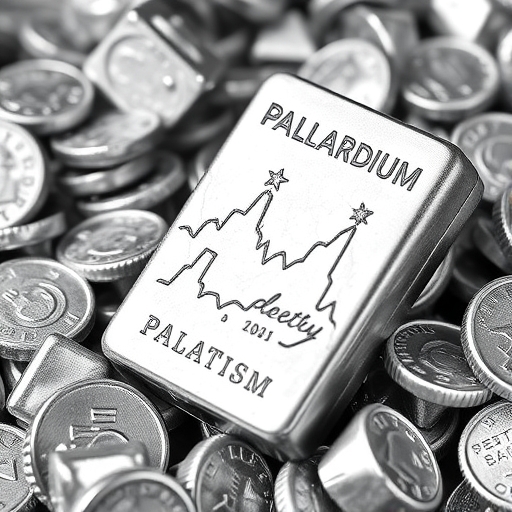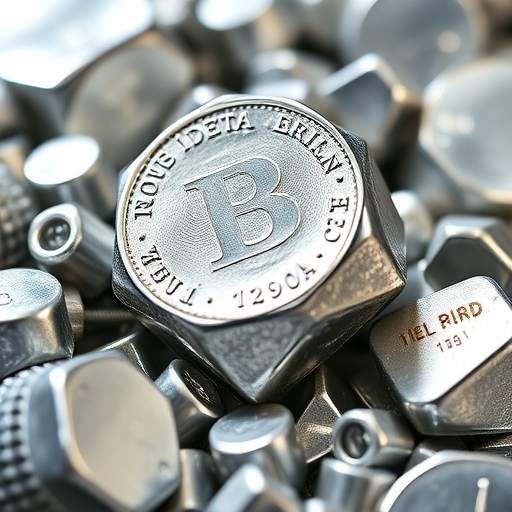Understanding Palladium Futures: A Comprehensive Guide to This Vital Precious Metal
Have you ever wondered about the hidden forces driving the price of a rare metal that’s essential for modern life? Palladium, a lesser-known but incredibly versatile precious metal, plays a pivotal role in diverse industries, from automotive manufacturing to electronics and dentistry. Its strategic importance is only amplified by the ongoing global push for clean energy and reduced emissions, positioning palladium futures as a vital instrument for risk management and portfolio diversification. In this comprehensive guide, we will delve into the unique characteristics of the palladium market, the mechanics of trading its futures contracts, and the key factors influencing its price dynamics, offering insights for both new and experienced traders. Join us as we explore how this silvery-white metal impacts the world and how you can engage with its market.

The Indispensable Role of Palladium in a Changing World
Palladium, a rare and lustrous silvery-white metal, is a distinguished member of the Platinum Group Metals (PGMs). Discovered in 1803 by William Hyde Wollaston, palladium has quietly become one of the most strategically important commodities globally. Its exceptional chemical properties make it indispensable across a wide array of applications. Perhaps its most critical function, accounting for approximately 75% of its demand, is in automotive catalytic converters. These devices are crucial for reducing harmful emissions from vehicles, directly linking palladium’s value to global automobile production and tightening environmental regulations.

Beyond the automotive industry, palladium’s versatility extends to various sectors. You’ll find it in electronics, particularly in multilayer ceramic capacitors, due to its conductivity and corrosion resistance. It’s also a staple in dentistry, used in crowns and bridges, and a popular choice for jewelry, often as an alloy for white gold. Furthermore, palladium plays a role in carbon monoxide detectors and even in groundwater treatment systems. With the world increasingly focused on the green energy transition, palladium’s importance is growing, especially in technologies aimed at clean energy and emission reduction. This expanding utility underscores why understanding the palladium market is more relevant than ever.
Key applications of palladium include:
- Automotive catalytic converters, crucial for reducing vehicle emissions.
- Electronics, especially in multilayer ceramic capacitors for conductivity and corrosion resistance.
- Dentistry, commonly used in crowns and bridges.
- Jewelry, often as an alloy in white gold.
- Various industrial uses, such as in carbon monoxide detectors and groundwater treatment systems.
- Emerging green energy technologies for emission reduction.
The global supply chain for palladium is highly concentrated. The primary producers are Russia and South Africa, which together hold about 90% of the world’s reserves and account for a significant portion of annual production. Other notable producers include Canada, the United States, and Zimbabwe. On the consumption side, North America, China, the European Union, and Japan are the major buyers, reflecting the global distribution of automotive and electronics manufacturing. This geographical concentration of both supply and demand makes the palladium market particularly sensitive to geopolitical events and economic shifts in these key regions.
Understanding the key players in the palladium market helps illustrate its global nature and sensitivity to regional events.
| Category | Major Regions/Countries | Approximate Share/Role |
|---|---|---|
| Primary Producers | Russia, South Africa | Approx. 90% of world reserves and significant production |
| Other Producers | Canada, United States, Zimbabwe | Contribute to global supply |
| Major Consumers | North America, China, European Union, Japan | Reflects automotive and electronics manufacturing hubs |
| Key Demand Driver | Global Automotive Industry | Accounts for ~75% of demand (catalytic converters) |
Mastering Palladium Futures: Contract Specifications and Trading Platforms
For those looking to engage with the palladium market, palladium futures contracts offer a standardized and efficient way to do so. But what exactly are futures? Simply put, a future is a standardized, exchange-traded contract to buy or sell a specified quantity of a commodity, like palladium, at a predetermined price on a future date. These contracts allow participants to manage price risk or speculate on price movements without owning the physical metal itself (at least not initially).
Most palladium futures contracts trade on the CME Group’s NYMEX (New York Mercantile Exchange) via the sophisticated CME Globex electronic platform. Trading hours are extensive, typically running from Sundays to Fridays, 5:00 p.m. to 4:00 p.m. CT (Central Time), with a one-hour break. This continuous trading allows participants from different time zones to react swiftly to global market developments. The contract unit for palladium futures is precisely 100 troy ounces of palladium, and prices are quoted in US dollars per troy ounce. Understanding these contract specifications is fundamental to successful trading.

Let’s look at some key specifications:
- Contract Unit: 100 troy ounces of palladium
- Price Quotation: US dollars per troy ounce
- Minimum Price Fluctuation: $0.50 per troy ounce
- Tick Size: This translates to $50.00 per contract (since 100 troy ounces * $0.50/troy ounce = $50.00)
- Contract Months: Futures are available for 3 consecutive months, plus March, June, September, and December for a total of 15 months, offering flexibility in choosing expiration dates.
- Settlement Method: Unlike some cash-settled contracts, palladium futures are settled by physical delivery. This means that if you hold a contract until expiration, you are obligated to deliver or take delivery of the actual palladium on the third last business day of the contract month.
For clarity, here’s a summary of the fundamental aspects of Palladium futures contracts.
| Specification | Detail |
|---|---|
| Exchange | CME Group’s NYMEX |
| Trading Platform | CME Globex (Electronic) |
| Contract Unit | 100 troy ounces of palladium |
| Price Quotation | US dollars per troy ounce |
| Minimum Price Fluctuation | $0.50 per troy ounce |
| Tick Value | $50.00 per contract |
| Settlement Method | Physical Delivery |
Trading these contracts requires an account with a futures broker and an initial margin deposit. This margin acts as a performance bond, covering potential losses. Because futures contracts are leveraged instruments, a relatively small amount of capital can control a large value of palladium, amplifying both potential gains and losses. For institutional traders, the block minimum for Palladium futures is 10 contracts, facilitating larger transactions. Familiar trading symbols include PA (for CME Globex and Clearing) and PAT (for TAS, Trade at Settlement). The transparency and deep liquidity offered by exchanges like CME Group facilitate efficient strategy execution and informed decision-making for market participants.
When engaging with palladium futures, it’s important to be aware of several trading considerations:
- An account with a futures broker is essential.
- An initial margin deposit is required as a performance bond.
- Futures are leveraged instruments, meaning small price movements can lead to significant gains or losses.
- For institutional traders, a block minimum of 10 contracts applies.
- Common trading symbols are PA (CME Globex/Clearing) and PAT (TAS).
Market Movers and Seasonal Trends: Decoding Palladium Price Dynamics
Understanding what drives palladium prices is crucial for anyone considering trading palladium futures. Several key factors can significantly influence its value, making it a dynamic and sometimes volatile commodity. As we’ve discussed, the most dominant factor is automobile industry demand, particularly for catalytic converters. Global vehicle production numbers, consumer preferences (e.g., diesel vs. gasoline engines), and stringent emission standards all play a direct role. A booming auto market often translates to higher palladium demand and, consequently, higher prices.

Another major influencer is supply shortages. The concentrated nature of palladium production in countries like Russia and South Africa means that geopolitical events, labor disputes, mining disruptions, or even adverse weather conditions in these regions can lead to significant supply shortfalls. When supply cannot keep pace with demand, prices tend to surge. For instance, you might recall palladium reaching an all-time high of $3425.00 in March 2022, partly driven by supply concerns stemming from geopolitical tensions.
The prices of substitutes also play a role. When palladium prices become exceptionally high, manufacturers may explore using alternative PGMs like platinum or even rhodium in catalytic converters or other industrial applications, where technically feasible. This substitution effect can cap palladium’s upside potential. Conversely, if substitute metals become too expensive, demand might shift back to palladium. Finally, the strength of the U.S. Dollar (USD) can influence palladium prices. Since palladium is quoted in USD, a stronger dollar can make the metal more expensive for international buyers, potentially reducing demand or incentivizing producers to increase supply, which could put downward pressure on prices.
Beyond these fundamental drivers, seasonal trading strategies also offer interesting insights into palladium’s price behavior. Historical data suggests that palladium futures tend to perform better in certain months. Specifically, we often observe stronger performance in December, January, and February. This seasonal strength might be linked to factors such as year-end inventory adjustments, renewed manufacturing demand at the start of a new year, or even specific climatic conditions affecting mining operations. While seasonality is not a guarantee of future performance, it can be a useful consideration for traders when developing their strategies.
Factors that may contribute to palladium’s seasonal strength include:
- Year-end inventory adjustments by manufacturers.
- Renewed manufacturing demand in the early months of a new calendar year.
- Potential impacts of specific climatic conditions on mining operations, particularly in major producing regions.
- Strategic buying and selling patterns by large institutional players at certain times of the year.
Consider the historical context: while the all-time high was in March 2022, palladium also saw an all-time low of $77.00 in May 1992. This wide range highlights the metal’s inherent volatility and the significant impact that supply-demand imbalances and broader economic factors can have over time. As of November 25, 2022, one source quoted the price at $1879.50 per troy ounce, showcasing its continued elevated value compared to historical lows.
Strategic Trading: Benefits, Risks, and Advanced Tools for Palladium Futures
Engaging with palladium futures offers a range of strategic advantages for various market participants, but it’s equally important to understand the inherent risks. For producers and consumers of palladium, a primary benefit is hedging. By taking an opposite position in the futures market to their physical market exposure, they can protect themselves against adverse price fluctuations, ensuring more predictable costs or revenues. For example, an auto manufacturer can lock in a price for future palladium supply, mitigating the risk of price spikes.
For investors and traders without physical exposure, speculation is a key draw. Futures contracts allow you to profit from anticipated price movements, either up or down, without the logistics of storing or delivering the physical metal. Furthermore, palladium futures can serve as a valuable tool for portfolio diversification. Commodities often move independently of traditional asset classes like stocks and bonds, helping to reduce systemic risk and enhance overall portfolio stability. In times of economic uncertainty or rising prices, palladium, like other precious metals, can also act as an inflation hedge, with its value often appreciating during inflationary periods.
A balanced perspective on palladium futures trading includes both its potential advantages and significant drawbacks.
| Benefit | Risk |
|---|---|
| Hedging against price fluctuations for producers/consumers. | Adverse price movements leading to substantial losses due to leverage. |
| Opportunity for speculation on price movements (long or short). | Relatively lower liquidity compared to other major commodities, impacting execution. |
| Portfolio diversification, as commodities may move independently of stocks/bonds. | High market cyclicality, heavily tied to the volatile automobile industry. |
| Potential as an inflation hedge during periods of rising prices. | Requirement for significant risk management and continuous market monitoring. |
However, the benefits come with significant risks. The most prominent is adverse price movement. Because futures contracts are highly leveraged, even small movements against your position can lead to substantial losses, potentially exceeding your initial margin deposit. Another consideration is the relatively low liquidity of palladium futures compared to more actively traded commodities like gold. While CME Group provides robust platforms, finding counterparties for large trades might occasionally be more challenging, potentially impacting execution efficiency. Finally, palladium’s price is subject to significant market cyclicality, heavily tied to the automobile industry’s ups and downs, which can lead to demand fluctuations and price volatility.
To navigate these dynamics, the CME Group offers an extensive suite of trading tools and educational resources. Access to real-time data and historical data (available through platforms like CME DATAMINE and integrated with Google Analytics Hub) is crucial for informed decision-making. Analytical tools such as the Expiration Calendar, Open Interest Profile Tool, Volatility Term Structure Tool, and the Commitment of Traders Tool provide deep insights into market sentiment, participant positioning, and potential price drivers. For those new to futures trading, CME Group provides valuable educational resources, including courses, and even challenges like the “Trade Against a Pro Trading Challenge,” designed to build practical trading skills. These resources, combined with expert market commentary, empower traders to develop and refine their palladium futures strategies effectively.
Palladium Investment Alternatives: ETFs and CFDs
While palladium futures offer a direct and leveraged way to gain exposure to the metal’s price movements, they aren’t the only option. For those who prefer a simpler, less hands-on approach, or wish to avoid the complexities of futures contracts, several alternatives exist. One popular choice is an Exchange Traded Fund (ETF) that tracks the spot price of palladium. For example, the abrdn Physical Palladium Shares ETF (PALL) is a well-known option that holds physical palladium bullion. Investing in PALL allows you to gain exposure to palladium’s price without directly trading futures or dealing with physical storage. A key advantage of physical commodity ETFs like PALL is that they avoid the “roll yield” issues that can sometimes affect futures-based ETFs, as they track the spot price rather than rolling forward futures contracts.
It’s important to note that, as of now, there are generally no ETFs that directly track palladium futures. This distinction is crucial for investors to understand, as physical ETFs behave differently than futures-based ones. Another alternative to futures trading is engaging with Contracts for Difference (CFDs) on palladium. Palladium CFDs offer a way to speculate on price movements without the complexities of contract expiration or physical delivery. When you trade a CFD, you are essentially entering into an agreement with a broker to exchange the difference in the price of palladium from the time the contract is opened until it is closed. This provides flexibility and can be simpler for some retail traders, though it relies on broker agreements rather than exchange-traded contracts.
Beyond palladium-specific products, the CME Group offers a diverse suite of other metals products that might interest investors seeking diversification. These include widely traded Gold futures/options and Copper futures, as well as smaller-sized contracts like Micro Gold, Micro Silver, and Micro Copper, which provide accessible entry points for smaller investors. The exchange also lists contracts for commodities like Uranium and Iron Ore China Portside Futures, expanding the universe of metals exposure. By understanding these various avenues, you can choose the investment vehicle that best aligns with your risk tolerance, capital, and trading objectives.
Conclusion
Palladium, a vital member of the Platinum Group Metals, continues to be a crucial commodity in our modern world, with its significance only growing amid the global green energy transition. From its indispensable role in automotive catalytic converters to its emerging applications in clean technologies, understanding the forces that shape the palladium market is paramount. We’ve explored the intricate mechanics of palladium futures contracts on platforms like CME Group’s NYMEX, detailing their specifications and the physical delivery settlement process. We’ve also delved into the key factors influencing palladium prices, including automobile demand, geopolitical supply risks, and the impact of substitute metals and the U.S. Dollar. Finally, we examined the strategic benefits of trading palladium futures, such as hedging and diversification, alongside their inherent risks, and highlighted alternative investment options like physically backed ETFs and CFDs.
Engaging with palladium futures offers a dynamic and increasingly relevant gateway into this vital commodity market. By combining knowledge of its industrial demand, global supply dynamics, trading mechanisms, and inherent risks, you can make more informed decisions. As the world continues its journey towards a greener future, palladium’s importance is set to grow, making informed engagement with its futures market a strategic imperative for investors and traders alike. Always remember that while commodity markets offer significant opportunities, they also carry substantial risk.
Disclaimer: This article is for educational and informational purposes only and does not constitute financial advice. Trading palladium futures or any other financial instrument involves significant risk and may not be suitable for all investors. You should consider your investment objectives, financial situation, and risk tolerance before making any investment decisions. Consult with a qualified financial professional before making any investment choices.
Frequently Asked Questions (FAQ)
Q: What is the primary use of palladium, and why is it so important?
A: The primary use of palladium, accounting for approximately 75% of its demand, is in automotive catalytic converters. It is crucial for reducing harmful emissions from vehicles, making it vital for environmental regulations and the global push for cleaner energy.
Q: How are palladium futures contracts settled?
A: Unlike some cash-settled contracts, palladium futures on the CME Group’s NYMEX are settled by physical delivery. This means that if a contract is held until expiration, the holder is obligated to deliver or take delivery of the actual 100 troy ounces of palladium.
Q: What are some alternatives to trading palladium futures for gaining exposure to the metal?
A: Alternatives include investing in Exchange Traded Funds (ETFs) that hold physical palladium bullion, such as the abrdn Physical Palladium Shares ETF (PALL). Another option is trading Contracts for Difference (CFDs) on palladium, which allows speculation on price movements without physical delivery or contract expiration complexities.



No responses yet